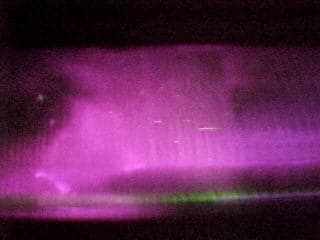
-----
Magnetic Particle Inspection: Linear indications on 4340 Steel?
Q. We perform magnetic particle and ultrasonic inspection of 4340 steel as well as the other 4XXX series steels. Periodically, we see linear indications that run in the long axis of the parts - sometimes multiple indications running in the long axis. We have identified this condition with magnetic particle inspection and ultrasonics. Can anyone share what the indications may be and how they are originated?

metal finishing shop - Wichita, Kansas
2005
|
A. When you remove a sample from an area showing these indications, and do the metallography on it, what is revealed? We might be able to help correlate the NDT observations with the realities of the microstructure if in fact you shared the details of the microstructure with us. Otherwise, it would just be wild guessing about what structural or processing aspects might conceivably be possible causes of the NDT observations, an approach which would not help anybody.  Bill Reynolds [deceased] consultant metallurgist - Ballarat, Victoria, Australia We sadly relate the news that Bill passed away on Jan. 29, 2010. 2005 A. There are a number of metallurgical causes of "non-relevant indications". Inclusions in the material, primarily manganese sulfides, are not uncommon. Microsegregation, wherein the alloying elements separate during solidification and never really get fully homogeneous again, also can occur.  Lee Gearhart metallurgist - E. Aurora, New York 2005 A. Many longitudinal seams or hair lines in steel bars come from imperfections on the original surface that always elongate during the lamination process where a bloom or billet is passed through a set of rolls to reduce its cross section and increase its length. This gives them the appearance of seams or cracks in the direction of rolling. This is frequently considered cause for rejection. Guillermo MarrufoMonterrey, NL, Mexico 2005 |
A. Since magnetic particle test is normally performed on wrought products (hot rolled products, forgings), my comments are based on these products.
I tend to agree w/ Bill Reynolds. ASTM A275, "Standard Test Method for Magnetic Particle Examination of Steel Forgings," addresses what to do in the event of "non-relevant indication". Sec. 13.3.4 states:
"Any indication that is believed to be nonrelevant shall be regarded as unacceptable until the indication is either eliminated by surface conditioning or it is reexamined by the same or other nondestructive means and demonstrated to be nonrelevant."
The same specification's definition for nonrelevent indications:
"3.1.5 nonrelevant indications-indications produced by leakage fields. However, the conditions causing them are present by design or accident, or other features of the part having no relation to the damaging flaws being sought. The term signifies that such an indication has no relation to the discontinuities that might constitute defects."
If you don't want to destroy the part in order to find out whether the indications is relevant (defect) or non-relevant (not a defect), then you can attempt to do an in-situ metallography to determine if the indication is related to a surface discontinuity (crack, seam, etc.) or inclusion (which may or may not be a surface discontinuity).
I have never encountered MP indications caused by sulfides. However, since sulfides are typically found in segregation bands, when the bandings are bad enough (when a forging receives too little or excessive forge reduction), these bandings will show up as faint, cluster-like indications in the direction of hot working. People sometimes call these indications as "flow lines". I personally don't consider these "flow lines". These indications are nowhere near as bright as a relevant indications and can be readily distinguished by an experienced NDT person.
The problems lies with that the end customer NDT person may not be familiar with non-relevant indications, while the forge company NDT personnels see these type of indications on regular basis (especially on frequency-severity bars for AMS 2301 or 2304) and always consider them acceptable. This is where the mutually agreed purchasing agreement for the particular part plays an important role in terms of resolving any disputes.
- northern Illinois, USA
Q. How we can differentiate the relevant and non-relevant indications in particle exams in MPI?
Ganesh Babu- UAE
March 10, 2013
Hi Ganesh. Michael H generously spent a good deal of time answering that question just above. Please try your best to express your continuing questions in terms of what he has said rather than starting over. Starting over is often the "kiss of death" to the discussion :-(
Regards,

Ted Mooney, P.E. RET
Striving to live Aloha
finishing.com - Pine Beach, New Jersey
Ted is available for instant help
or longer-term assistance.
May 2018
Q, A, or Comment on THIS thread -or- Start a NEW Thread